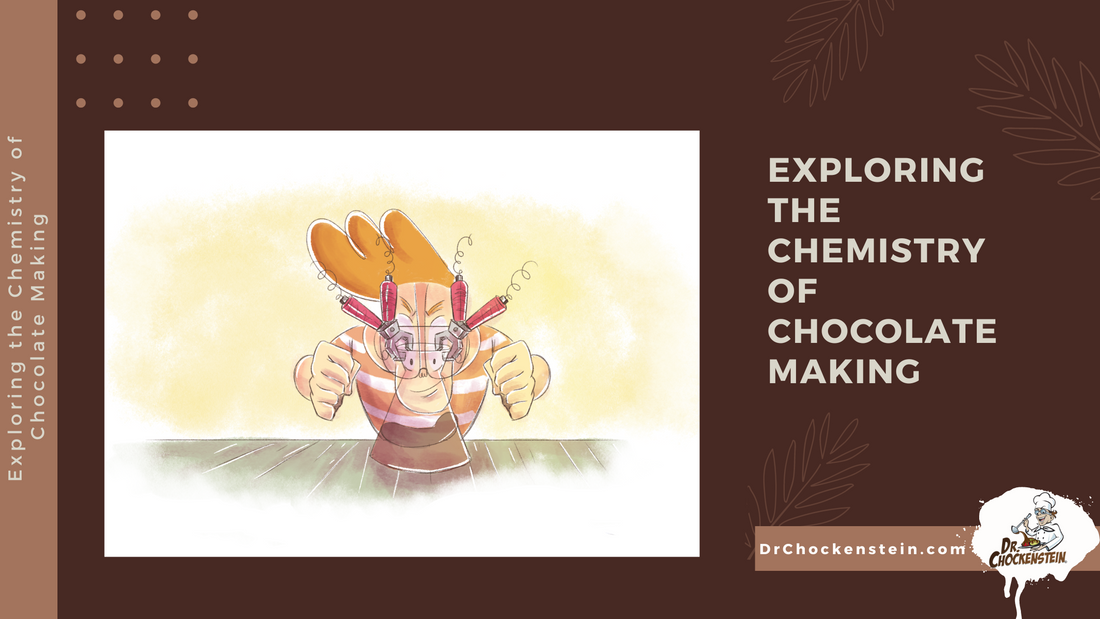
Exploring the Chemistry of Chocolate Making
Share
Have you ever wondered how chemistry is used to create delicious chocolate? Chocolate making is much more than just melting and mixing ingredients. It's a complex process that relies heavily on chemistry – from the size and shape of cocoa particles to the chemistry of flavor compounds to the balance between fat and sugar. Understanding chemistry is essential for crafting the perfect chocolate! In this blog, we'll explore how chemistry is used in the art of chocolate making. We'll also discuss stem education and why young people need to learn chemistry and its applications.
Let's get started!
The chemistry of cocoa particles plays an important role in chocolate making. Cocoa particles must be small and uniform in size to ensure a smooth texture and uniform flavor. The chemistry behind this process involves the manipulation of cocoa particle size distribution through milling, sieving, and tempering. To reduce the particle size, manufacturers use grinding mills that generate frictional heat, which breaks the cocoa particles into smaller pieces. This process is known as milling and it's an essential step in chocolate making.
In addition to reducing particle size, manufacturers also use sieving machines to separate oversized particles from the desired ones. The chemistry behind this involves a balance between air pressure and sieve mesh openings. Finally, to ensure that the cocoa particles are evenly distributed, manufacturers use tempering machines. In this process, the chocolate is heated and cooled in a controlled manner so that it can form stable crystals with uniform sizes and shapes. When done properly, these crystals give the chocolate its glossy sheen and snap as it breaks.
The chemistry of flavor compounds is also an integral part of chocolate making. When cocoa beans are processed, complex biochemical reactions take place that results in the flavors and aromas we associate with chocolate. The chemistry behind this involves breaking down proteins, lipids, carbohydrates, and other molecules into their parts, which can then interact with one another to create unique flavor compounds.
To further enhance the flavor of chocolate, manufacturers use a variety of ingredients to create different varieties. For example, adding milk or cream can give the chocolate a rich, creamy texture and smooth sweetness; adding nuts or fruits can provide crunchiness and tartness, and adding spices like cinnamon or nutmeg can add complexity and depth to the flavor profile. All these ingredients interact with one another through chemistry and create a symphony of flavors that make chocolate so delicious!
The chemistry behind the balance between fat and sugar is also an important part of chocolate making. The cocoa butter in chocolate acts as a carrier for the other ingredients, giving the chocolate its creamy texture and mouthfeel. The chemistry behind this involves the formation of crystal networks that act as binding agents between fat and sugar molecules, which helps stabilize their interactions. When these crystal networks are formed properly, it creates a balance that results in a smooth texture and rich flavor profile.
Too much fat can cause the chocolate to become greasy and too much sugar can result in an overly sweet flavor. Achieving the perfect balance between these two components requires a deep understanding of chemistry, which is why it's so important for chocolatiers to have a good grasp on this subject.
The chemistry behind chocolate making makes it an ideal topic to explore in STEM education. By teaching students the chemistry and physics of cocoa processing, manufacturers can ensure that future generations have a better understanding of the complex processes involved. This knowledge can help them create unique and delicious chocolates for people around the world to enjoy.
In addition, students can apply the chemistry of chocolate making to other areas, such as food science or chemistry. By studying the chemical interactions that take place when different ingredients are brought together, students can gain a better understanding of how these compounds interact and how they can be used in other applications.
Overall, chemistry is an essential component of chocolate making and is an ideal topic for STEM education. By gaining a better understanding of this chemistry, students can use it to create delicious chocolates and explore its applications in other areas.
Chocolate making also requires an understanding of food safety, as chocolate is a perishable product that must be stored and handled properly. Temperature and humidity levels influence the chemistry of chocolate, and manufacturers need to ensure that their products are stored in the right conditions. Otherwise, they risk creating an environment that can lead to mold growth or other forms of spoilage.
Additionally, manufacturers must be aware of food allergens and other potential contaminants that can hurt the chemistry of chocolate. By understanding these safety guidelines and implementing them into their production processes, chocolatiers can ensure that their products remain safe for consumption.
In sum, understanding the chemistry of chocolate is essential for creating the best product possible, but it's equally important to ensure that food safety protocols are followed. By doing so, manufacturers can ensure that their products stay safe and delicious for everyone to enjoy.
We hope youve enjoyed exploring the Chemistry of Chocolate Making. Please share with your network and check out our blog for more chocolate articles.
If you're interested in learning more about the chemistry of chocolate making, be sure to check out the links below. They provide in-depth information on the subject and can help you gain a better understanding of this complex process.
Chemistry of Chocolate: https://www.acs.org/content/acs/en/education/highschool/chemistry/units/unit4/chocolate.html
STEM Education: https://www.edx.org/course/stem-education-towards-a-more-inclusive-future-uc-berkeleyx-cii#
Food Science: https://www.biologydiscussion.com/food-science/food-chemistry/4689-application-food-chemistry-chocolate.html
Chemistry: https://www.thoughtco.com/the-chemistry-of-chocolate-1991972
